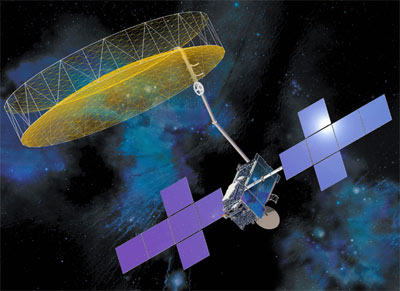TerreStar to FCC: Almost Done
Posted by samc on August 8th, 2007TerreStar Networks defended its request to the FCC to delay its mobile satellite launch 10 months, claiming it “is in the public interest,” reports RCR News.
The Reston, Va.-based firm in late May asked the FCC for permission to extend the launch of the planned 2 GHz mobile satellite service until September 2008, citing a need to accommodate manufacturing and delivery issues of its satellite suppler, Space Systems/Loral.
Originally scheduled for delivery in 2007, TerreStar-1 will carry an 18-meter reflector (below) provided by Harris for their 2 GHz (MSS) service.
The TerreStar satellite will generate many dozens of spot beams covering the Continental U.S., Canada, Alaska, Hawaii, Puerto Rico and the U.S. Virgin Islands.
TerreStar’s 2 GHz MSS service would have been followed by MSV’s L-Band service, in 2009 and 2010 (pdf).
But Inmarsat Global last week said TerreStar was seeking “fundamental changes” to the system just months prior to launch. Inmarsat claimed the proposed changes raise “serious questions about the relationship between the timing of these voluntary design choices and TerreStar’s inability to meet its upcoming November 2007 launch milestone.”
TerreStar, a majority-owned subsidiary of Motient Corp., responded in a letter to the FCC claiming it has made “substantial progress” both in the construction of its satellite and in the construction and implementation of supporting terrestrial facilities. The company said Inmarsat failed to provide legal or factual basis for denying the delay request, and claimed once again that the speedbumps in construction are outside of its control.
Inmarsat uses the “L” band but generally requires small VSATs (usually on ships). Inmarsat hopes to compete with TerreStar’s 18 meter reflector with their own 9 meter reflector on I-4 satellites.
While Iridium and Globalstar use LEO satellites, and send everything up to the bird, Motient and Inmarsat plan to use GEO satellites with spot beams. Terrastar and MVS will also add terrestrial repeaters (ATCs) to deliver satellite telephony and data.
Motient’s MSV-1 and MSV-2 will replace and expand upon the current MSAT satellite system operated by MSV and MSV Canada. They will cover Canada and the United States. The third satellite, MSV-SA will introduce MSV’s advanced communications services into South America. Boeing is building the spacecraft, based on the world’s most powerful satellite – the Boeing 702.
Their 22 meter L-band reflector for mobile terminal links will dwarf Inmarsat’s 9 meter antenna and provide terrestrial repeaters. MSV has contracted with ILS for the launch in 2009 and Sea Launch for the launch in 2010 for their two, high-powered domestic satellites for North America.
 Meanwhile, Inmarsat has also signed a contract with International Launch Services (ILS) to provide a launch of the third Inmarsat-4 satellite in March-April 2008 on a Proton launch vehicle from the Baikonur Cosmodrome in Kazakhstan. It will be positioned over the Pacific and provide oceanic and west coast coverage for North America.
Meanwhile, Inmarsat has also signed a contract with International Launch Services (ILS) to provide a launch of the third Inmarsat-4 satellite in March-April 2008 on a Proton launch vehicle from the Baikonur Cosmodrome in Kazakhstan. It will be positioned over the Pacific and provide oceanic and west coast coverage for North America.
Three I-4 satellites were built for Inmarsat by EADS Astrium. They use a 9 meter AstroMesh reflector built by Northrop Grumman. The I-4 F1 was launched in March 2005, and is now orbiting over the Indian Ocean at 64 degrees East; the I-4 F2 was launched in November 2005, provides coverage for the Americas from 154 degrees West.
Not to be left out, Iridium today announced it has contracted seven partners in the beginning phase of its “Iridium NEXT” satellite constellation. It is expected to cost more than US$2 billion to build and deploy, becoming fully operational by 2016. Future services could include environmental monitoring, photography and a GPS system to complement the current Global Positioning System.
source : dailywireless.org





No comments:
Post a Comment